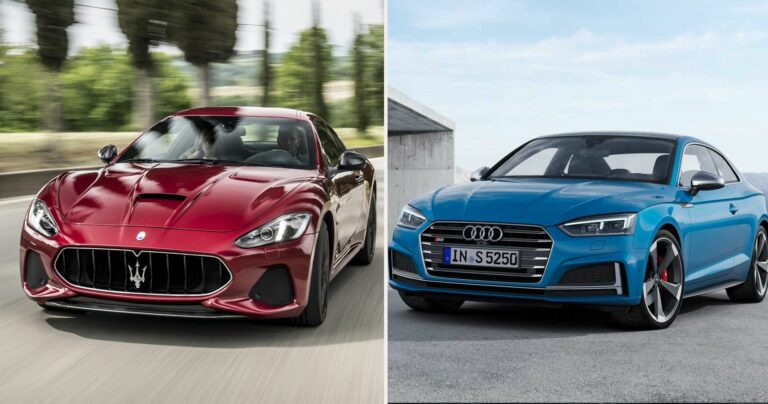Best Car Amplifier Brands: Powering Your Perfect Car Audio Experience
Best Car Amplifier Brands: Powering Your Perfect Car Audio Experience cars.truckstrend.com
In the world of car audio, clarity, depth, and sheer power are not just luxuries; they are the hallmarks of an exceptional listening experience. While high-quality speakers and a feature-rich head unit lay the foundation, it’s the car amplifier that truly unlocks their potential. Far from being a mere accessory, a car amplifier is the heart of a robust audio system, taking the weak signals from your stereo and boosting them into clean, powerful currents that bring your music to life. Without a dedicated amplifier, even the most expensive speakers will struggle to deliver their full dynamic range, leading to distorted sound, weak bass, and an overall underwhelming performance.
This comprehensive guide will delve into the critical role of car amplifiers, the key factors to consider when selecting one, and a curated list of the best car amplifier brands that consistently deliver superior sound quality, reliability, and performance. Whether you’re an audiophile chasing pristine sound or a bass-head craving earth-shaking lows, understanding the right amplifier can transform your daily commute into a concert hall on wheels.
Best Car Amplifier Brands: Powering Your Perfect Car Audio Experience
Why You Need a Car Amplifier: Beyond Just "Louder"
Many assume an amplifier simply makes music louder. While it certainly does increase volume, its primary function is to deliver cleaner power, which dramatically improves sound quality in several ways:
- Eliminates Distortion: Car stereos have built-in amplifiers, but they often lack the power to drive aftermarket speakers effectively. When pushed, these internal amps "clip" the audio signal, introducing harsh, unpleasant distortion. A dedicated amplifier provides ample, clean power, preventing this clipping even at higher volumes.
- Unlocks Speaker Potential: Aftermarket speakers, especially component sets and subwoofers, are designed to handle more power than a head unit can provide. An amplifier allows these speakers to perform as intended, delivering richer mid-ranges, clearer highs, and more impactful bass.
- Enhanced Bass Response: Subwoofers, in particular, demand significant power. An amplifier dedicated to a subwoofer can deliver the precise, sustained power needed to produce deep, articulate, and punchy bass that you can feel as well as hear.
- Improved Dynamic Range: With more headroom (the difference between average and peak power), an amplifier allows your system to reproduce the subtle nuances of quiet passages and the explosive impact of loud crescendos with greater fidelity.
- Future Upgradeability: Installing an amplifier provides a solid foundation for future audio upgrades, such as adding more powerful speakers or a subwoofer, without needing to replace your head unit.

Key Factors to Consider When Choosing an Amplifier
Selecting the right amplifier involves more than just picking a brand. A thoughtful approach to these technical specifications and features will ensure you get the best match for your specific audio needs:
- Power Output (RMS vs. Peak): This is perhaps the most crucial specification.

- RMS (Root Mean Square) Power: This is the continuous power an amplifier can produce. Always match your amplifier’s RMS output to your speakers’ RMS power handling. This ensures your speakers receive consistent, clean power without being overdriven or underpowered.
- Peak Power: This is the maximum power an amplifier can produce for a brief instant. While impressive on paper, it’s less relevant for sustained performance and should be largely ignored in favor of RMS.
- Number of Channels:

- Mono (1-channel): Ideal for powering a single subwoofer.
- 2-Channel: Perfect for a pair of full-range speakers or bridgeable to power a single, more powerful subwoofer.
- 4-Channel: Most popular for powering two pairs of full-range speakers (e.g., front and rear door speakers). Can also be bridged to power a pair of subwoofers or a set of components and a single subwoofer.
- 5-Channel: An all-in-one solution, typically providing four channels for full-range speakers and one dedicated mono channel for a subwoofer. Great for space-saving installations.
- Amplifier Class (A/B, D, etc.): This refers to the amplifier’s internal design and efficiency.
- Class A/B: Known for excellent sound quality with minimal distortion, but less efficient (around 50-60%) and tends to run hotter. Often preferred for full-range speakers where fidelity is paramount.
- Class D: Highly efficient (80-90% or more), compact, and runs cooler. Ideal for high-power applications, especially subwoofers, but modern Class D designs are increasingly used for full-range applications with great results.
- Frequency Response: The range of frequencies the amplifier can reproduce (e.g., 20 Hz – 20,000 Hz). A wider range indicates better fidelity across the entire audio spectrum.
- Signal-to-Noise Ratio (SNR): Measured in decibels (dB), this indicates how much cleaner the audio signal is compared to background noise. A higher SNR (e.g., >90 dB) means less audible hiss.
- Total Harmonic Distortion (THD): A percentage indicating the amount of distortion added to the signal. Lower is better (e.g., <0.1% for full-range, <1% for subwoofers).
- Input Sensitivity (Gain Control): Allows you to match the amplifier’s input level to the output voltage of your head unit. Proper gain setting is crucial for preventing distortion.
- Built-in Crossovers (LPF, HPF): Low-Pass Filters (LPF) allow only low frequencies to pass (for subwoofers), while High-Pass Filters (HPF) allow only high frequencies to pass (for full-range speakers). These are essential for directing the right frequencies to the right speakers and preventing damage.
- Dimensions and Mounting: Consider where you plan to install the amp (under a seat, in the trunk) and ensure it will fit and receive adequate ventilation.
Best Car Amplifier Brands: Our Top Picks
When it comes to reliability, performance, and innovation, certain brands consistently rise to the top. Here are some of the best car amplifier brands, each offering unique strengths:
-
JL Audio: Renowned for their uncompromising sound quality and robust build, JL Audio amplifiers are a favorite among audiophiles. Their "Slash" and "XDv2" series are particularly praised for their clean power, efficiency, and advanced thermal management. They excel in both full-range and subwoofer amplification, delivering precise, detailed sound reproduction. While often at a premium price point, the investment is justified by their superior performance and longevity.
-
Rockford Fosgate: A legendary name in car audio, Rockford Fosgate is synonymous with raw power and bulletproof reliability, especially for bass enthusiasts. Their "Punch" and "Power" series amplifiers are designed to deliver massive amounts of clean power, making them ideal for driving high-performance subwoofers and SPL (Sound Pressure Level) systems. They offer excellent value for their power output and are built to withstand demanding conditions.
-
Alpine: Known for their balanced approach, Alpine amplifiers offer a fantastic blend of sound quality, power, and features across a wide range of price points. Their "PDX" series is celebrated for its compact size, impressive efficiency (Class D), and clean power delivery, making them versatile for both full-range speakers and subwoofers. Alpine amps are a great choice for those seeking a well-rounded system with clear, dynamic sound.
-
Kicker: If you’re looking for amplifiers that deliver "punch" and powerful bass, Kicker is a go-to brand. Their "CX" and "KXA" series amps are popular for their robust power output, often exceeding their rated specifications, and their ability to drive subwoofers with authority. Kicker amps are built tough and are a favorite among those who prioritize impactful bass and high-volume performance.
-
Audison / Hertz (Elettromedia Group): These Italian brands represent the pinnacle of high-end car audio amplification. Audison (especially their "Voce," "Thesis," and "AP" series) focuses on audiophile-grade sound quality, offering incredible detail, staging, and musicality. Hertz, while also premium, often leans slightly more towards power and impact without sacrificing fidelity. Both brands are for the discerning listener willing to invest in an elite listening experience.
-
Pioneer / Kenwood: These mainstream electronics giants offer a wide range of reliable and value-oriented amplifiers. While they might not reach the extreme performance levels of niche audiophile brands, their amplifiers (like Pioneer’s "GM-D" series or Kenwood’s "KAC" series) provide solid performance, good features, and excellent reliability for daily drivers. They are a great choice for upgrading a factory system or building a budget-friendly aftermarket setup without compromising too much on quality.
Practical Advice and Actionable Insights
- Match RMS, Not Peak: This cannot be stressed enough. Always choose an amplifier whose RMS power output matches the RMS power handling of your speakers or subwoofer.
- Don’t Skimp on Wiring: The best amplifier is useless without proper wiring. Invest in high-quality oxygen-free copper (OFC) power, ground, and speaker wires of appropriate gauge to prevent power loss and ensure clean signal transfer.
- Proper Gain Setting is Critical: The gain knob on an amplifier is not a volume control. It matches the amplifier’s input sensitivity to your head unit’s output voltage. Incorrectly setting the gain (too high) is the leading cause of speaker damage and distorted sound. Use a digital multimeter (DMM) or seek professional help to set it accurately.
- Consider Installation Location: Ensure your amplifier has adequate ventilation. Mounting it in a confined space without airflow can lead to overheating and thermal shutdown, potentially shortening its lifespan.
- Professional Installation vs. DIY: While DIY installation is possible, especially for experienced individuals, professional installation ensures proper wiring, safe mounting, and precise gain setting. If you’re unsure, it’s worth the investment.
Maintaining Your Car Amplifier
Maintaining your amplifier is relatively simple but important for its longevity:
- Keep it Clean: Periodically wipe down the amplifier to prevent dust buildup, which can act as an insulator and cause overheating.
- Ensure Airflow: Regularly check that vents are not blocked by debris or objects.
- Check Connections: Over time, vibrations can loosen connections. Periodically inspect power, ground, and speaker wire connections to ensure they are secure.
Estimated Price Range for Best Car Amplifier Brands
Please note: Prices are highly variable based on model, power output, number of channels, retailer, and promotions. The ranges below are approximate and serve as a general guide.
| Brand | Typical Amp Type(s) | Key Features | Estimated Price Range (USD) |
|---|---|---|---|
| JL Audio | Mono, 2-Ch, 4-Ch, 5-Ch | High-end sound quality, robust build, advanced thermal management, clean power. | $300 – $1500+ |
| Rockford Fosgate | Mono, 2-Ch, 4-Ch, 5-Ch | High power output, durability, strong bass, value for power. | $200 – $1200+ |
| Alpine | Mono, 2-Ch, 4-Ch, 5-Ch | Balanced sound, compact size (PDX), efficiency, reliable performance. | $180 – $1000+ |
| Kicker | Mono, 2-Ch, 4-Ch, 5-Ch | Powerful bass, robust build, often exceed rated power, impactful sound. | $150 – $900+ |
| Audison / Hertz | Mono, 2-Ch, 4-Ch, 5-Ch | Audiophile-grade sound, superior detail, high-fidelity components, premium. | $400 – $2000+ |
| Pioneer | Mono, 2-Ch, 4-Ch | Good value, reliable, compact Class D options, solid performance. | $100 – $500+ |
| Kenwood | Mono, 2-Ch, 4-Ch | Reliable, good features, competitive pricing, often includes bass boost. | $100 – $500+ |
Note: "$100-500+" indicates a range from entry-level models to more powerful mid-range options from that brand. High-end models from any brand can exceed these ranges significantly.
Frequently Asked Questions (FAQ)
Q: Do I really need a car amplifier? My stereo sounds fine.
A: While your factory stereo produces sound, it likely lacks the power and clarity to truly bring your music to life. An amplifier provides cleaner, more robust power, significantly reducing distortion, improving bass response, and allowing aftermarket speakers to perform at their full potential. If you care about sound quality, yes, you absolutely need one.
Q: What’s the difference between Class A/B and Class D amplifiers?
A: Class A/B amps are known for excellent sound quality and low distortion but are less efficient (run hotter, draw more power). Class D amps are highly efficient (run cooler, draw less power, smaller size) and are excellent for high-power applications like subwoofers. Modern Class D technology has advanced significantly, making them suitable for full-range applications with great sound quality.
Q: How many channels do I need for my amplifier?
A:
- 1-channel (Mono): For a single subwoofer.
- 2-channel: For a pair of full-range speakers (e.g., front doors) or bridgeable for one powerful subwoofer.
- 4-channel: For two pairs of full-range speakers (e.g., front and rear doors).
- 5-channel: An all-in-one solution for four full-range speakers and one subwoofer.
Q: Can I install a car amplifier myself?
A: Yes, if you have a good understanding of car electrical systems, proper tools, and follow detailed instructions. However, improper wiring can lead to poor performance, blown fuses, or even electrical fires. If you’re unsure, it’s highly recommended to seek professional installation.
Q: How do I match an amplifier to my speakers?
A: The most important factor is matching the amplifier’s RMS power output to your speakers’ RMS power handling. If your speakers are rated for 75 watts RMS, look for an amplifier that delivers close to 75 watts RMS per channel at the same impedance (ohms). Avoid matching peak power ratings.
Q: What is "gain setting" on an amplifier, and how do I do it?
A: Gain control matches the amplifier’s input sensitivity to the output voltage of your head unit. It’s not a volume knob. Setting it correctly prevents distortion. The best way to set gain is using a digital multimeter (DMM) to measure the AC voltage output or by using an oscilloscope. Setting it by ear often leads to distortion and potential speaker damage.
Q: What size fuse do I need for my amplifier?
A: The fuse size depends on the amplifier’s total RMS power output and the gauge of the power wire. Always refer to your amplifier’s manual for the recommended fuse rating. An inline fuse should be placed within 18 inches of your car’s battery for safety.
Conclusion
Choosing the best car amplifier brand is a pivotal step in transforming your vehicle’s audio system from ordinary to extraordinary. By understanding the core benefits of an amplifier, delving into key specifications, and recognizing the strengths of reputable brands like JL Audio, Rockford Fosgate, Alpine, Kicker, Audison, Pioneer, and Kenwood, you are well-equipped to make an informed decision. Remember to prioritize RMS power matching, invest in quality wiring, and ensure proper installation for a safe, reliable, and truly immersive listening experience. With the right amplifier, every drive becomes an opportunity to enjoy your favorite music with unparalleled clarity, depth, and power.





